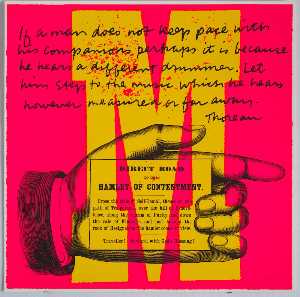Corita Kent
Corita Kent
Style: Pop Art;
Place: Fort Dodge
Born: 1918
Death: 1986
Biography:
Corita Kent and Chouinard Art Institute and earned her BA from Immaculate Heart College in 1941. She earned her MA at the University of Southern California in Art History in 1951. Between 1938 and 1968 Kent lived and worked in the Immaculate Heart Community. She taught in the Immaculate Heart College and became the chair of its art department in 1964. Her classes at Immaculate Heart were an avant-garde mecca for prominent, ground-breaking artists and inventors, such as Alfred Hitchcock, John Cage, Saul Bass, Buckminster Fuller and Charles & Ray Eames. Kent credited Charles Eames, Buckminster Fuller, and art historian Dr. Alois Schardt for their important roles in her intellectual and artistic growth. By the early 1950s, she had such a unique and well-known aesthetic and teaching style that clergy members from all over the country were sent to be educated at Immaculate Heart College. Her students were drawn to her selflessness and unique teaching methods such as large class assignments like asking students to create 200 drawings or take three hours to draw their arm without looking at what they were creating. She toured widely the following decade. After the Second Vatican Council, Kent transformed Immaculate Heart College’s annual Mary’s Day procession into a community celebration which was part of the sister’s campaign to bring secular people together. During this time, Kent’s work became increasingly political, addressing events such as the Vietnam War and humanitarian crises. For example, she was commissioned by the Physicians for Social Responsibility to create what she called “we can create life without war” billboards. Tensions between the order and church leadership were mounting, with the Los Angeles archdiocese criticizing the college as “liberal” and Cardinal James McIntyre labeling the college as “communist” and Kent’s work as “blasphemous.” Due to this, Kent returned to secular life in 1968 as Corita Kent. Most sisters followed suit and the Immaculate Heart College closed in 1980.
In 1985, Kent’s design for a United States Postal Service Stamp is issued. She did not attend the unveiling because she wanted it to happen at the United Nations and was not happy with the message that was sent when the design was unveiled on the Love Boat. Her 1985 work "love is hard work" was made in response. The stamp itself sold successfully- over 700 million times.
After she left the order, she moved to Boston, where she devoted herself to making art. Her split from the Immaculate Heart Community was emotional and difficult for her, since her religious faith was a central element of her life for decades.
Corita Kent was diagnosed with cancer in 1974. After this diagnosis, in the Back Bay of Boston, Kent confined her art to water color painting and only pursued printmaking if it was in order to say something substantiative. She died on September 18, 1986 in Watertown Massachusetts at the age of sixty-seven. She left her copyrights and unsold works to the Immaculate Heart College Community.
Kent created several hundred serigraph designs, for posters, book covers, and murals. Her work includes the 1985 United States Postal Service stamp Love and the 1971 Rainbow Swash, the largest copyrighted work of art in the world, covering a 150-foot (46 m) high natural gas tank in Boston. Kent was also commissioned to create work for the 1964 World’s Fair in New York, and the 1965 IBM Christmas display in New York. Her 1951 print, The Lord is with Thee had won first prizes in printmaking at the Los Angeles County Museum of History, Science, Art, and at the California State Fair.
More...
Wikipedia link: Click Here














